Chartbook #16: Outpatient Prescription Drug Expenses in the U.S. Community Population, 2003
By Marie N. Stagnitti, MPA.
Contents
The estimates in this report are based on the most recent data available from MEPS at the time the report was written. However, selected elements of MEPS data may be revised on the basis of additional analyses, which could result in slightly different estimates from those shown here. Please check the MEPS Web site www.meps.ahrq.gov for the most current file releases.
The mission of AHRQ is to improve the quality, safety, efficiency, and effectiveness of health care for all Americans by:
- Using evidence to improve health care.
- Improving health care outcomes through research.
- Transforming research into practice.
Executive Summary
In 2003, outpatient prescription drug expenses in the U.S. civilian noninstitutionalized population totaled $177.7 billion and accounted for approximately 20% of total health expenses.
The average prescription drug expense per person in the community population (including people with no expenses) was $611. The average per person with an expense (about 64% of the population) was $950.
Medicare beneficiaries comprised only 15% of the community population but accounted for 42% of prescription medicine expenses. The average drug expense was about four times larger for Medicare beneficiaries ($1,774) than for the non-Medicare population ($413).
The top 10% of the population (that is, the 10% of the population with the highest drug spending) accounted for 69% of prescribed drug expenses for the non-Medicare population and 41% of prescribed drug expenses among Medicare beneficiaries.
Nearly half (45%) of the total spending for outpatient prescription drugs was paid by patients and their families. This percentage was more than twice as large as the out-of-pocket share for total health expenses (20%).
Medicare beneficiaries paid for a much larger portion of their drug expenses out of pocket (51%) than the non-Medicare population (40%).
Drug expenses were concentrated among people in fair or poor health in both the Medicare and non-Medicare population.
The five therapeutic classes of drugs accounting for the largest expenses in the community population in 2003 were cardiovascular agents, hormones, central nervous system agents, psychotherapeutic agents, and antihyperlipidemic agents.
The top five therapeutic classes of drugs accounting for the largest expenses for elderly Medicare beneficiaries in the community population in 2003 were cardiovascular agents, antihyperlipidemic agents, hormones, central nervous system agents, and gastrointestinal agents.
Return to Table of Contents
Foreword
The mission of the Agency for Healthcare Research
and Quality (AHRQ) is to improve the quality, safety, efficiency,
and effectiveness of health care for all Americans. The Medical Expenditure
Panel Survey (MEPS)
helps AHRQ fulfill its mission by providing information on health
care use and expenses, health insurance, health status, and a variety of
demographic,
social, and economic characteristics. MEPS is a set of large-scale
surveys of families and individuals, their medical providers, and employers
across
the United States.
MEPS provides various ways of accessing the data so that it can be most useful to you. The MEPS Web site, www.meps.ahrq.gov, has:
- Online publications to read or download.
- MEPS public use data files that you can review and download.
- MEPSNet, which allows analysis of MEPS data using online statistical tools.
- Tables showing MEPS data displayed by some of the most frequently used characteristics.
AHRQ welcomes questions and comments from readers of this publication who are interested in obtaining more information about access, cost, use, financing, and quality of health care in the United States. We also invite you to tell us how you are using this Chartbook and other MEPS data and tools and to share suggestions on how MEPS products might be enhanced to further meet your needs. Please
e-mail us at mepspd@ahrq.gov or send a letter to the address below:
Steven B. Cohen, Ph.D.
Director
Center for Financing, Access, and Cost Trends
Agency for Healthcare Research and Quality
540 Gaither Road
Rockville, MD 20850
Return to Table of Contents
Introduction
This chartbook presents data from the 2003 Medical Expenditure Panel Survey (MEPS) on spending for outpatient prescription medicines for the U.S. civilian noninstitutionalized population with a focus on comparisons between the Medicare and non-Medicare populations. The chartbook is organized into three sections. Section 1 presents a summary of overall outpatient prescription medicine expenses and payments. Section 2 contains outpatient prescription medicine expenses and payments by various population groups. Section 3 contains expenses on outpatient prescription drugs by therapeutic class. See the Definitions of Terms section for information and definitions on the categories used throughout the chartbook.
This chartbook and other MEPS publications
are available electronically on the MEPS Web site at www.meps.ahrq.gov.
Return to Table of Contents
Source of Data
The estimates shown in this chartbook are drawn from
analyses from the following public use files: 2003 Full Year Consolidated
Data File HC-079 and 2003 MEPS Prescribed Medicines File HC-077A,
which are available on the MEPS Web site. Over-the-counter and free sample
medicines
are not included in the estimates. Drugs were assigned to therapeutic
classes by linking HC-077A to the Multum Lexicon database, a product of
Cerner Multum,
Inc. (http://www.multum.com).
Only differences that are statistically significant at the 0.05 level are discussed in the text. In some cases, totals may not add precisely to 100% because of rounding.
Return to Table of Contents
Section 1: Overview: Medicare/Non-Medicare
Outpatient prescription drugs play an ever-increasing role in health care delivery in the United States. MEPS data show that total outpatient drug expenses for the U.S. civilian non-institutionalized population grew from $65.3 billion in 1996 to $177.7 billion in 2003, an increase of 172%. Furthermore, prescription medicine spending increased its share of overall health care spending from 12% in 1996 to 20% in 2003.
This section presents information on overall expenses and sources of payments for outpatient prescription drugs used by the community population in 2003. It highlights and compares various statistics for the total, Medicare, and non-Medicare populations. It also presents information on the concentration of expenses for the total, Medicare, and non-Medicare populations. This information is useful in determining how equitably and efficiently drug resources are used.
What proportion of the U.S. community population has outpatient prescription medicine expenses?
- In 2003, 64% of the 290.6 million people in the U.S. civilian noninstitutionalized population had an outpatient prescription drug expense.
- Outpatient prescription drug expenses totaled $177.7 billion, accounting for approximately 20% of total health care spending.
- The community population purchased a total of 2.8 billion prescriptions, an average of almost 10 prescriptions per person.
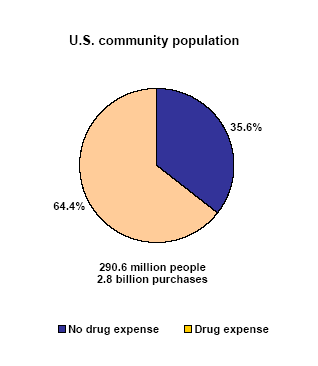
U.S. community population |
| Drug expense |
No drug expense |
| 64.4% |
35.6% |
What are the mean and median expenses for prescription medicines in the community population?
- In 2003, half of the community population had drug expenses of less than $62 (the median value). Thirty-six percent of people with expenses below the median did not have any drug expense. The mean (average) expense per person was $611.
- Among people with at least one drug purchase, the mean drug expense ($950) was about three times larger than the median expense ($306).
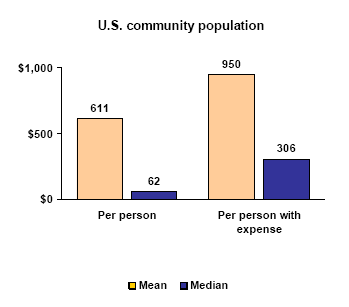
U.S. community population |
| |
Per person |
Per person with expense |
| Mean |
$611 |
$950 |
| Median |
$62 |
$306 |
Return to Table of Contents
Is the distribution of expenses throughout the population different for prescription medicines than for total health care?
- In 2003, the distribution of expenses for the top 10% and top 30% throughout
the population was similar for prescription medicines and all health care.
- For both types of expenses, the 10% of the population with the highest spending accounted for nearly two-thirds of the total, and the top 30% accounted for around 90% of the total.
- The bottom 50% accounted for a larger share of total health expenses (3%) than of drug expenses (1%).
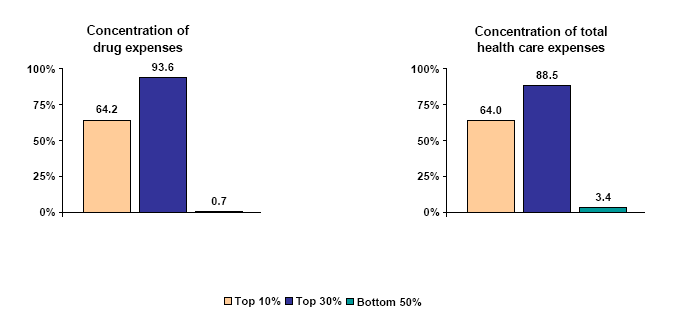
Concentration of
drug expenses |
| Top 10% |
64.2% |
| Top 30% |
93.6% |
| Bottom 50% |
0.7% |
|
| Concentration of total health care expenses |
| Top 10% |
64.0% |
| Top 30% |
88.5% |
| Bottom 50% |
3.4% |
|
To what extent do Medicare beneficiaries purchase a disproportionate share of prescription medicines?
- In 2003, the 42.4 million Medicare beneficiaries comprised about 15% of the community population yet accounted for 42% of total prescription drug purchases and 42% of total prescription medicine expenses.
- The average drug expense per Medicare beneficiary ($1,774) was more than four times as large as the average expense for the non-Medicare population ($413).
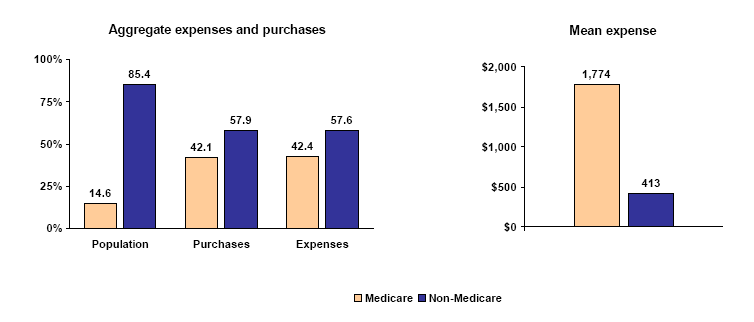
Aggregate expenses and purchases |
| |
Medicare |
Non-Medicare |
| Population |
14.6% |
85.4% |
| Purchases |
42.1% |
57.9% |
| Expenses |
42.4% |
57.6% |
|
Mean expense |
| Medicare |
Non-Medicare |
| $1,774 |
$413 |
|
Return to Table of Contents
What factors account for higher average prescription medicine expenses for the Medicare population?
- In 2003, the difference in the average expense per prescription for the Medicare and non-Medicare populations was $64 versus $60.
- A higher percentage of the Medicare population (90%) than the non-Medicare population (60%) purchased at least one prescription drug.
- The average number of prescription drug purchases for people with an
expense was higher for Medicare beneficiaries (31) than for the non-Medicare
population (11).
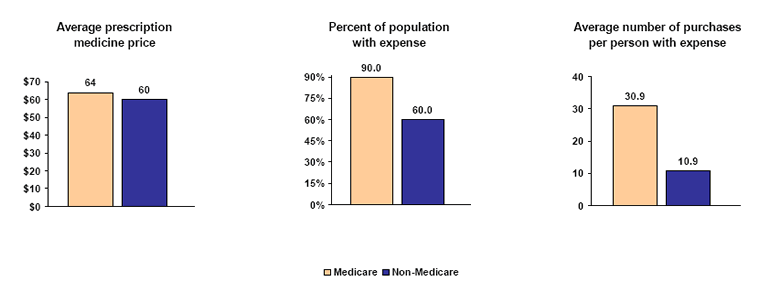
Average prescriptionmedicine price |
| Medicare |
Non-Medicare |
| $64 |
$60 |
|
Percent of population
with expense |
| Medicare |
Non-Medicare |
| 90% |
60% |
|
Average number of purchases
per person with expense |
| Medicare |
Non-Medicare |
| 30.9 |
10.9 |
|
How are prescription medicine expenses concentrated in the Medicare and non-Medicare populations?
- In 2003, outpatient drug expenses were more concentrated in the non-Medicare population than among Medicare beneficiaries.
- The top 10% of the population (that is, the 10% of the population with the highest drug spending) accounted for 41% of expenses for the Medicare population and 69% of expenses for the non-Medicare population. Similarly, the top 30% of the population accounted for 73% of Medicare drug expenses and 95% of non-Medicare expenses.
- The bottom 50% (those below the median drug expense of $1,038 for Medicare beneficiaries and $33 for the non-Medicare population) accounted for 10% of Medicare drug expenses and less than 1% of non-Medicare drug expenses.
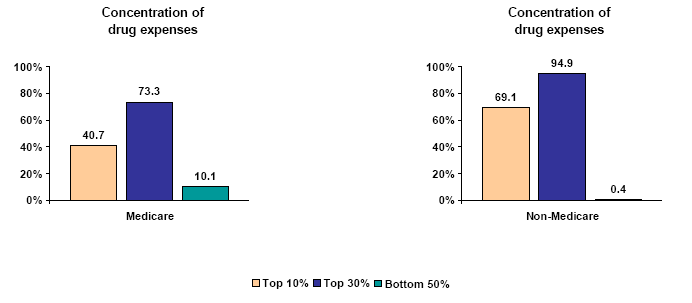
Concentration of
drug expenses
Medicare
|
| Top 10% |
40.7% |
| Top 30% |
73.3% |
| Bottom 50% |
10.1% |
|
Concentration of
drug expenses
Non-Medicare |
| Top 10% |
69.1% |
| Top 30% |
94.9% |
| Bottom 50% |
0.4% |
|
Return to Table of Contents
Who pays for prescription medicines?
- In 2003, 45% of the $177.7 billion spent for outpatient prescription drugs was paid by patients and their families (out of pocket). In comparison, only 20% of overall health care spending was paid for out of pocket.
- Private health insurance was the largest third-party payer for prescription drugs, accounting for more than a third (36%) of total expenses. Public insurers-primarily Medicaid-and other sources accounted for the remaining 20% in expenses.
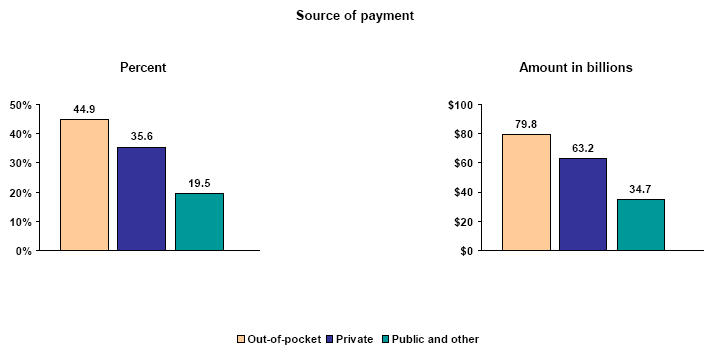
Source of payment
Percent
|
| Out of Pocket |
44.9% |
| Private |
35.6% |
| Public and other |
19.5% |
|
Source of payment
Amount in billions
|
| Out of Pocket |
$79.8 |
| Private |
$63.2 |
| Public and other |
$34.7 |
|
Return to Table of Contents
Are sources of payment different for the Medicare and non-Medicare populations?
- In 2003, out-of-pocket payments accounted for about half (51%) of all prescription payments for Medicare beneficiaries but for only two-fifths (40%) of prescription payments for the non-Medicare population.
- The share of prescription expenses paid by private insurance for Medicare beneficiaries (21%) was less than half the share paid by private insurance for the non-Medicare population (46%).
- The share of prescription drug expenses paid by public insurance and other sources was over twice as large for Medicare beneficiaries (28%) than for the non-Medicare population (13%).
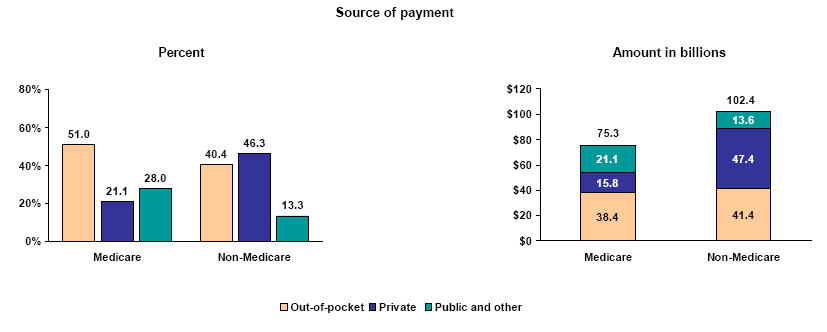
Source of payment
Percent
|
| |
Medicare |
Non-Medicare |
| Out of Pocket |
51.0% |
40.4% |
| Private |
21.1% |
46.3% |
| Public and other |
28.0% |
13.3% |
|
Source of payment
Amount in Billions
|
| |
Medicare |
Non-Medicare |
| Out of Pocket |
$38.4 |
$41.4 |
| Private |
$15.8 |
$47.4 |
| Public and other |
$21.1 |
$13.6 |
|
Return to Table of Contents
What is the insurance status of the Medicare and non-Medicare populations?
- In 2003, a little over half of all Medicare beneficiaries had Medicare and supplemental private insurance (55%). Smaller proportions had Medicare only (29%) or Medicare and other public insurance (16%).
- Nearly three-quarters (73%) of the non-Medicare population had some private insurance. An additional 13% had public insurance only and the remaining 14% were uninsured.
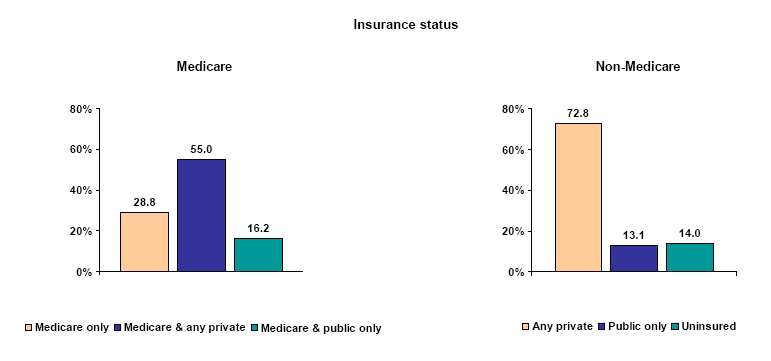
Insurance status
Medicare
|
| Medicare only |
28.8% |
| Medicare and any private |
55.0% |
| Medicare and public only |
16.2% |
|
Insurance status
Non-Medicare
|
| Any private |
72.8% |
| Public only |
13.1% |
| Uninsured |
14.0% |
|
Return to Table of Contents
Does the out-of-pocket payment share vary by insurance status?
- In 2003, Medicare beneficiaries who did not have supplemental health insurance paid for three-quarters of their drug expenses out of pocket. The out-of-pocket share was smaller for beneficiaries with any private insurance (48%) or Medicare and public insurance only (31%).
- In 2003, uninsured people paid for 88% of their drug expenses out of pocket. The out-of-pocket share was smaller for people in the non-Medicare population with any private insurance (39%) or public insurance only (30%).
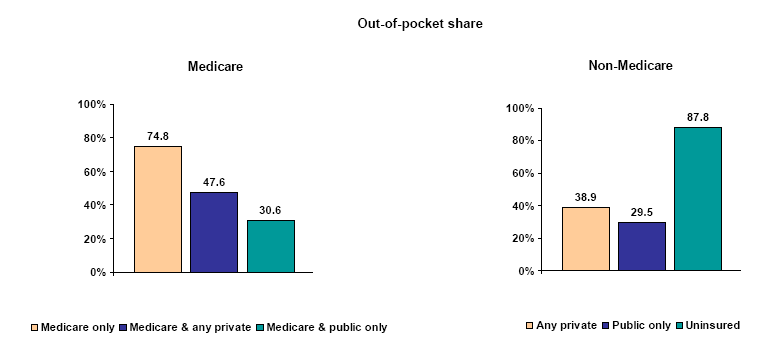
Out-of-pocket share
Medicare
|
| Medicare only |
74.8% |
| Medicare and any private |
47.6% |
| Medicare and public only |
30.6% |
|
Out-of-pocket share
Non-Medicare
|
| Any private |
38.9% |
| Public only |
29.5% |
| Uninsured |
87.8% |
|
Return to Table of Contents
Do out-of-pocket payments for prescription medicines make up a large share of out-of-pocket payments for health care?
- Although prescription medicines accounted for approximately 20% of total health care expenses in 2003, they accounted for nearly one-half (45%) of all out-of-pocket expenses.
- The share of all out-of-pocket health spending that went for prescription medicines was three-fifths (60%) for Medicare beneficiaries but only 37% for the non-Medicare population.
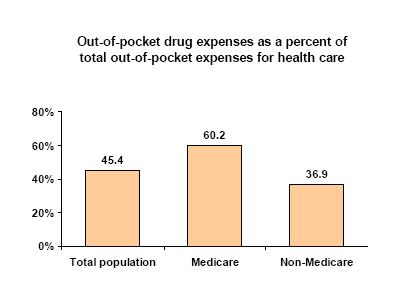
Out-of-pocket drug expenses as a percent of
total out-of-pocket expenses for health care |
| Total population |
45.4% |
| Medicare |
60.2% |
| Non-Medicare |
36.9% |
|
Return to Table of Contents
Section 2: Population Subgroups
Use and expenses for prescription drugs vary across subgroups of the community population for many reasons. It is necessary to be cognizant of these variations in order to make appropriate health care policy decisions regarding prescription drugs. Two such areas include 1) an understating of how total, third-party, and out-of-pocket expenses vary across subgroups of the community population, and 2) an understanding of the extent to which drug expenses are concentrated within certain subgroups.
This section presents information on total expenses, third-party, and out-of-pocket expenses by age, race/ethnicity, sex, health insurance status, income, perceived health status, and region. Results are presented for the total, Medicare and non-Medicare populations.
Are prescription medicine expenses highly concentrated in certain age groups?
- In 2003, Medicare covered not only elderly people but also younger people with certain disabilities and people with end-stage renal disease (permanent kidney failure with dialysis or a transplant, sometimes called ESRD). Expenses for Medicare beneficiaries were somewhat concentrated in the non-elderly age group. Medicare beneficiaries under age 65 represented 14% of the population but accounted for 21% of expenses.
- In the non-Medicare population, prescription medicine expenses were
concentrated among people in the two older age groups. Persons
age 45-54 comprised 16% of the population and 27% of total expenditures,
and persons
age 55-64 made up 11% of the population and 31% of total expenditures-27%
of the population accounted for 57% of total expenditures. In
contrast, people under age 45 made up 73% of the non-Medicare population
but accounted
for only about 43% of drug expenses.
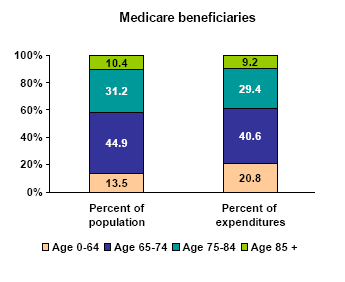 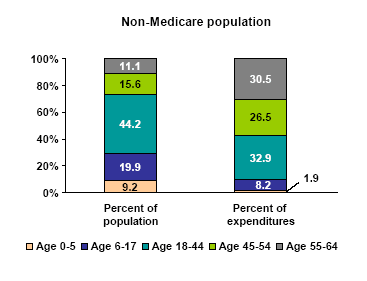
|
| |
Percent of population |
Percent of expenditures |
| Age 0-64 |
13.5% |
20.8% |
| Age 65-74 |
44.9% |
40.6% |
| Age 75-84 |
31.2% |
29.4% |
| Age 85+ |
10.4% |
9.2% |
|
|
| |
Percent of population |
Percent of expenditures |
| Age 0-5 |
9.2% |
1.9% |
| Age 6-17 |
19.9% |
8.2% |
| Age 18-44 |
44.2% |
32.9% |
| Age 45-54 |
15.6% |
26.5% |
| Age 55-64 |
11.1% |
30.5% |
|
Return to Table of Contents
Are prescription medicine expenses highly concentrated among any race or ethnic group?
- In 2003, drug expenses were not noticeably disproportionately concentrated
in any group of Medicare beneficiaries classified by their race/ethnicity.
- In 2003, drug expenses for the non-Medicare population were somewhat concentrated among white, non-Hispanics. White, non-Hispanics represented 66% of the population and 77% of total expenditures. In contrast, Hispanics made up 15% of the population but accounted for only 8% of total expenditures.
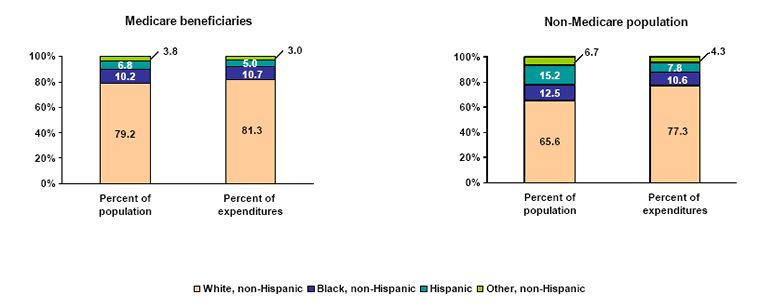
|
| |
Percent of population |
Percent of expenditures |
| White, non-Hispanic |
79.2% |
81.3% |
| Black, non-Hispanic |
10.2% |
10.7% |
| Hispanic |
6.8% |
5.0% |
| Other, non-Hispanic |
3.8% |
3.0% |
|
|
| |
Percent of population |
Percent of expenditures |
| White, non-Hispanic |
65.6% |
77.3% |
| Black, non-Hispanic |
12.5% |
10.6% |
| Hispanic |
15.2% |
7.8% |
| Other, non-Hispanic |
6.7% |
4.3% |
|
Return to Table of Contents
Are prescription medicine expenses highly concentrated among men or women?
- In 2003, drug expenses among Medicare beneficiaries were not disproportionately concentrated among men or women.
- In 2003, drug expenses were more concentrated among women in the non-Medicare population. Women represented 50% of the population and 59% of total expenditures, whereas men represented 50% of the population and only 41% of total expenditures.
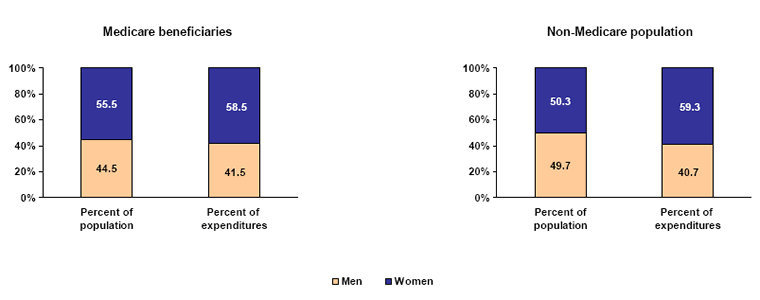
|
| |
Percent of population |
Percent of expenditures |
| Men |
44.5% |
41.5% |
| Women |
55.5% |
58.5% |
|
|
| |
Percent of population |
Percent of expenditures |
| Men |
49.7% |
40.7% |
| Women |
50.3% |
59.3% |
|
Are prescription medicine expenses highly concentrated among people with private insurance?
- In 2003, drug expenses were somewhat disproportionately concentrated in the group of Medicare beneficiaries with Medicare and public insurance only. Those with Medicare and public insurance only represented 16% of the population but accounted for 21% of expenses.
- Among the non-Medicare population, drug expenses were less concentrated among the uninsured. The uninsured made up 14% of the population but accounted for only 6% of total prescribed medicine expenditures.
|
| |
Percent of population |
Percent of expenditures |
| Medicare only |
28.8% |
25.4% |
| Medicare and any private |
55.0% |
54.0% |
| Medicare and public only |
16.2% |
20.7% |
|
|
| |
Percent of population |
Percent of expenditures |
| Any private |
72.8% |
79.0% |
| Public only |
13.1% |
14.9% |
| Uninsured |
14.0% |
6.1% |
|
Return to Table of Contents
Are prescription medicine expenses highly concentrated among people in fair or poor health?
- In 2003, people in fair or poor health represented 29% of the Medicare population yet accounted for 45% of total prescription medicine expenses. Conversely, those in excellent, very good, and good health made up 71% of the population but accounted for 55% of total prescribed medicine expenses.
- In the non-Medicare population, people in fair or poor health represented 8% of the population but accounted for over a quarter, 28%, of total prescription medicine expenses. In contrast, those in excellent, very good, and good health made up 92% of the population yet only accounted for 72% of total expenditures.
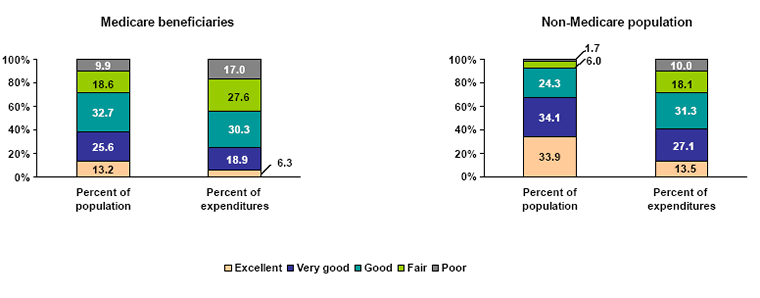
|
| |
Percent of population |
Percent of expenditures |
| Excellent |
13.2% |
6.3% |
| Very good |
25.6% |
18.9% |
| Good |
32.7% |
30.3% |
| Fair |
18.6% |
27.6% |
| Poor |
9.9% |
17.0% |
|
|
| |
Percent of population |
Percent of expenditures |
| Excellent |
33.9% |
13.5% |
| Very good |
34.1% |
27.1% |
| Good |
24.3% |
31.3% |
| Fair |
6.0% |
18.1% |
| Poor |
1.7% |
10.0% |
|
Return to Table of Contents
Are prescription medicine expenses highly concentrated among lower income groups?
- In 2003, prescription medicine spending was not disproportionately concentrated in any income group of Medicare beneficiaries.
- Among the non-Medicare population, prescription medicine expenses were
not disproportionately concentrated among the poor but were disproportionately
concentrated among those in the highest income group.
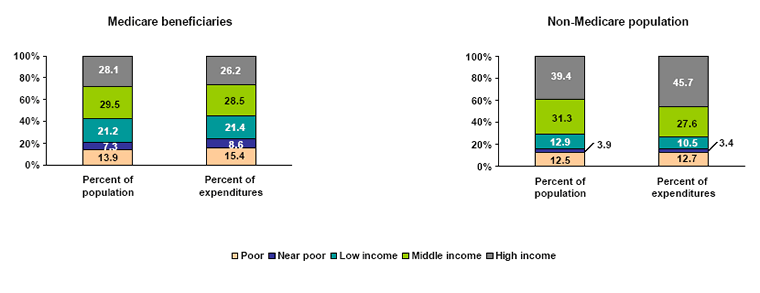
|
| |
Percent of population |
Percent of expenditures |
| Poor |
13.9% |
15.4% |
| Near Poor |
7.3% |
8.6% |
| Low income |
21.2% |
21.4% |
| Middle income |
29.5% |
28.5% |
| High income |
28.1% |
26.2% |
|
|
| |
Percent of population |
Percent of expenditures |
| Poor |
12.5% |
12.7% |
| Near Poor |
3.9% |
3.4% |
| Low income |
12.9% |
10.5% |
| Middle income |
31.3% |
27.6% |
| High income |
39.4% |
45.7% |
|
Return to Table of Contents
Are prescription medicine expenses highly concentrated in any region of the country?
- In 2003, for Medicare beneficiaries, prescription medicine spending was not disproportionately concentrated in any region of the country.
- Among the non-Medicare population, prescription medicine spending was less concentrated in the West.
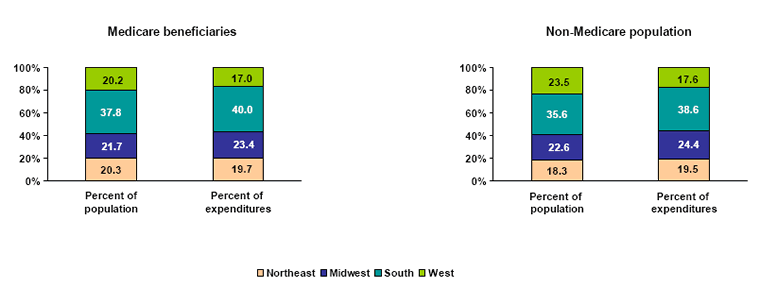
|
| |
Percent of population |
Percent of expenditures |
| Northeast |
20.3% |
19.7% |
| Midwest |
21.7% |
23.4% |
| South |
37.8% |
40.0% |
| West |
20.2% |
17.0% |
|
|
| |
Percent of population |
Percent of expenditures |
| Northeast |
18.3% |
19.5% |
| Midwest |
22.6% |
24.4% |
| South |
35.6% |
38.6% |
| West |
23.5% |
17.6% |
|
Return to Table of Contents
How do per user prescription medicine expenses vary by age?
- In 2003, non-elderly beneficiaries had the highest average prescription expense per user among Medicare beneficiaries ($3,263).
- Average annual drug expenses per user in the non-Medicare population
increased steadily with age going from $148 for children under
age 6 to $1,421 for the 55-64 age group.
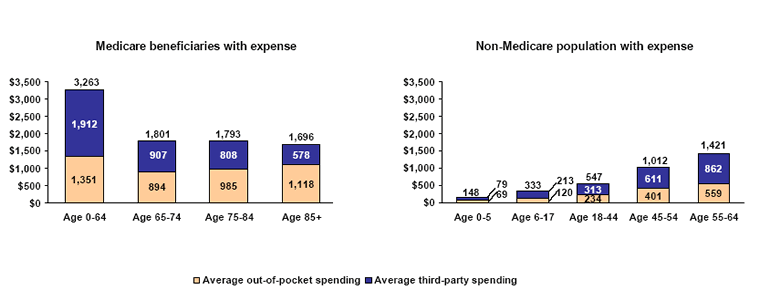
Medicare beneficiaries with expense
|
| |
Average
out-of-pocket
spending |
Average
third-party
spending |
| Age 0-64 |
$1,351 |
$1,912 |
| Age 65-74 |
$894 |
$907 |
| Age 75-84 |
$985 |
$808 |
| Age 85+ |
$1,118 |
$578 |
|
Non-Medicare population with expense
|
| |
Average
out-of-pocket
spending |
Average
third-party
spending |
| Age 0-5 |
$69 |
$79 |
| Age 6-17 |
$120 |
$213 |
| Age 18-44 |
$234 |
$313 |
| Age 45-54 |
$401 |
$611 |
| Age 55-64 |
$559 |
$862 |
|
Return to Table of Contents
Do per user prescription medicine expenses vary by race/ethnicity?
- In 2003, for those Medicare beneficiaries with a prescribed drug expense, Hispanics had a lower average expense ($1,622) than white, non-Hispanics ($1,984) and black, non-Hispanics ($2,207).
- In the non-Medicare population, per user, the average expense for Hispanics for prescription drugs ($466) was lower than the average expense for white, non-Hispanics ($742) and black, non-Hispanics ($661).
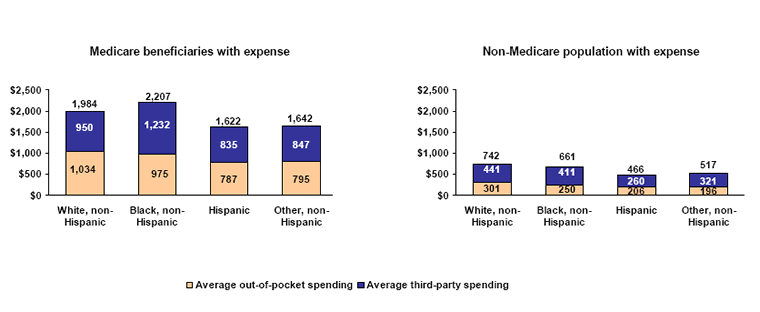
Medicare beneficiaries with expense
|
| |
Average
out-of-pocket
spending |
Average
third-party
spending |
| White, non-Hispanic |
$1,034 |
$950 |
| Black, non-Hispanic |
$975 |
$1,232 |
| Hispanic |
$787 |
$835 |
| Other, non-Hispanic |
$795 |
$847 |
|
Non-Medicare population with expense
|
| |
Average
out-of-pocket
spending |
Average
third-party
spending |
| White, non-Hispanic |
$301 |
$441 |
| Black, non-Hispanic |
$250 |
$411 |
| Hispanic |
$206 |
$260 |
| Other, non-Hispanic |
$196 |
$321 |
|
Return to Table of Contents
Do per user prescription medicine expenses vary by sex?
- In 2003, on average, total prescribed drug expense for Medicare beneficiaries with an expense was not significantly different for men and women; however, on average, out-of-pocket payments for women were higher ($1,128) than for men ($843).
- In the non-Medicare population, for those with a prescription drug expense, on average, total expenses and out-of-pocket payments were higher for women than for men.
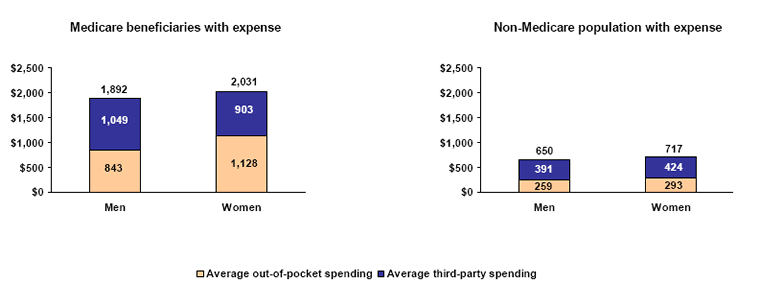
Medicare beneficiaries with expense
|
| |
Average out-of-pocket spending |
Average third-party spending |
| Men |
$843 |
$1,049 |
| Women |
$1,128 |
$903 |
|
Non-Medicare population with expense
|
| |
Average out-of-pocket spending |
Average third-party spending |
| Men |
$259 |
$391 |
| Women |
$293 |
$424 |
|
Return to Table of Contents
Do per user prescription medicine expenses vary by insurance status?
- In 2003, the average expense for Medicare beneficiaries with an expense ranged from $2,604 for those people with public insurance only coverage in addition to Medicare to $1,809 for those with no coverage other than Medicare.
- The average out-of-pocket expense for Medicare beneficiaries with a prescription drug expense was highest for those people with no coverage other than Medicare.
- In the non-Medicare population, for those with an expense, the uninsured had the lowest average total expense but the highest average out-of-pocket expense when compared to those with public insurance only and those with any private insurance.
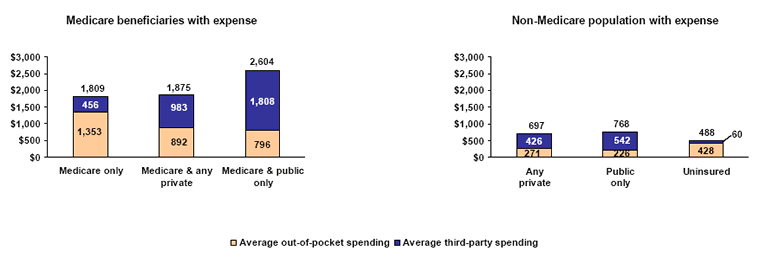
Medicare beneficiaries with expense
|
| |
Average out-of-pocket spending |
Average third-party spending |
| Medicare only |
$1,353 |
$456 |
| Medicare and any private |
$892 |
$983 |
| Medicare and public only |
$796 |
$1,808 |
|
Non-Medicare population with expense
|
| |
Average out-of-pocket spending |
Average third-party spending |
| Any private |
$271 |
$426 |
| Public only |
$226 |
$542 |
| Uninsured |
$428 |
$60 |
|
Return to Table of Contents
Is health status related to per user prescription medicine expenses?
- In 2003, average prescription medicine expenses for people with an expense increased as health status worsened for both the Medicare and non-Medicare populations.
- The average out-of-pocket expense for those with a prescribed medicine expense increased as health status worsened for Medicare beneficiaries and the non-Medicare population.
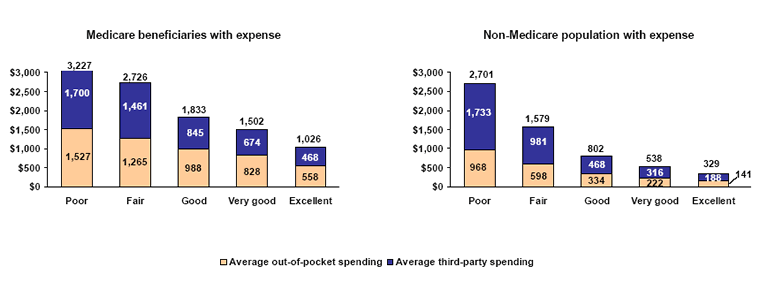
Medicare beneficiaries with expense
|
| |
Average out-of-pocket spending |
Average third-party spending |
| Poor |
$1,527 |
$1,700 |
| Fair |
$1,265 |
$1,461 |
| Good |
$988 |
$845 |
| Very good |
$828 |
$674 |
| Excellent |
$558 |
$468 |
|
Non-Medicare population with expense
|
| |
Average out-of-pocket spending |
Average third-party spending |
| Poor |
$968 |
$1,733 |
| Fair |
$598 |
$981 |
| Good |
$334 |
$468 |
| Very good |
$222 |
$316 |
| Excellent |
$141 |
$188 |
|
Return to Table of Contents
How are income and per user prescription medicine expenses related?
- In 2003, for those Medicare beneficiaries with an expense, the average total expense was higher for the poor than those in the middle and high income groups. The average out-of-pocket expense was lower for those in the high income group than those in the near poor, low income, and middle income groups.
- In the non-Medicare population, for those with an expense, average out-of-pocket expense remained stable, ranging from $297- $254 for all income groups. Those in the high income group had a higher average total expense than those in the middle and low income groups. Those who were poor had a higher average total expense than those in the middle income group.
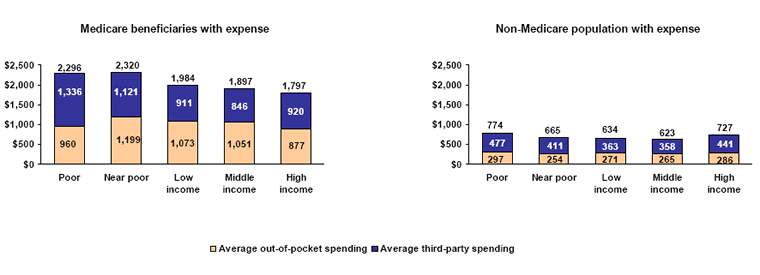
Medicare beneficiaries with expense
|
| |
Average out-of-pocket spending |
Average third-party spending |
| Poor |
$960 |
$1,336 |
| Near Poor |
$1,199 |
$1,121 |
| Low income |
$1,073 |
$911 |
| Middle income |
$1,051 |
$846 |
| High income |
$877 |
$920 |
|
Non-Medicare population with expense
|
| |
Average out-of-pocket spending |
Average third-party spending |
| Poor |
$297 |
$477 |
| Near Poor |
$254 |
$411 |
| Low income |
$271 |
$363 |
| Middle income |
$265 |
$358 |
| High income |
$286 |
$441 |
|
Return to Table of Contents
Is region related to per user prescription medicine expenses?
- In 2003, for Medicare beneficiaries with a prescribed medicine expense, those in the West and the Northeast had a lower average out-of-pocket expense compared to those in the Midwest and the South.
- In the non-Medicare population, for those with a prescription drug expense, people living in the South had the highest out-of-pocket expense compared to those living in the Northeast, Midwest, and West.
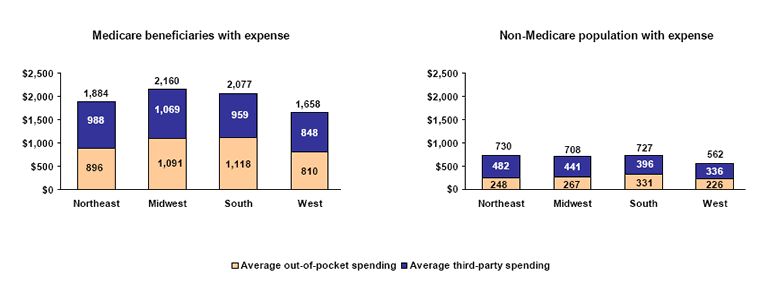
Medicare beneficiaries with expense
|
| |
Average out-of-pocket spending |
Average third-party spending |
| Northeast |
$896 |
$988 |
| Midwest |
$1,091 |
$1,069 |
| South |
$1,118 |
$959 |
| West |
$810 |
$848 |
|
Non-Medicare population with expense
|
| |
Average out-of-pocket spending |
Average third-party spending |
| Northeast |
$248 |
$482 |
| Midwest |
$267 |
$441 |
| South |
$331 |
$396 |
| West |
$226 |
$336 |
|
Return to Table of Contents
Section 3: Therapeutic Classes of Drugs
Outpatient prescription medicines are used in the treatment of a wide range of medical conditions, from the management of chronic conditions, such as diabetes and high cholesterol, to the treatment of acute conditions, such as influenza and strep throat. To obtain a complete picture of outpatient prescription drug use, it is imperative to have an understanding of the types of drugs that are most commonly used by the community population as well as various subgroups.
This section presents information on the top five therapeutic
classes of prescribed medicines (such as cardiovascular agents, hormones,
and antihyperlipidemic agents) that accounted for the largest percentage
of expenses for the U.S. community population and several population subgroups,
and also provides the percentage of people using these types of prescribed
drugs.
The population groups for which data are presented are the U.S. community population, elderly Medicare beneficiaries, non-elderly Medicare beneficiaries (under age 65), non-Medicare adults (age 18- 64), and non-Medicare children (under age 18).
Therapeutic classes were assigned to drugs using Multum Lexicon variables from Cerner Multum, Inc. The therapeutic class of central nervous system agents includes the large sub-class of analgesics. The therapeutic class of antihyperlipidemic agents includes the large subclass of HMG-COA reductase inhibitors. The therapeutic class of psychotherapeutic agents includes the large subclass of antidepressants. For additional information on these and other Multum Lexicon variables, as well as the Multum Lexicon database itself, please refer to the following Web site: http://www.multum.com/Lexicon.htm.
What are the top five therapeutic classes of prescribed drugs when ranked by total expenses for the U.S. community population?
- In 2003, of the $177.7 billion spent on prescription drugs by the community
population, the largest percentage was spent on cardiovascular agents
(16%). The remaining four in the top five therapeutic classes were hormones
(14%), central nervous system agents (13%), psychotherapeutic agents (11%),
and antihyperlipidemic (cholesterol-reducing) agents (11%). The top five
therapeutic classes combined accounted for 65% of total prescribed drug
expenses.
- Of the top five therapeutic classes, central nervous system agents were
used by the highest percentage of people (24%), followed by
hormones (20%), cardiovascular agents (18%), psychotherapeutic agents
(11%), and antihyperlipidemic
agents (10%).

| Top five therapeutic classes for the U.S. community population |
Percent of total drug expenses
|
| Cardiovascular agents |
16.1% |
| Hormones |
13.9% |
| Central Nervous system agents |
13.2% |
| Psychotherapeutic agents |
10.9% |
| Antihyperlipidemic agents |
10.5% |
|
| Top five therapeutic classes for the U.S. community population |
Percent of population
with expense
|
| Cardiovascular agents |
18.4% |
| Hormones |
20.1% |
| Central Nervous system agents |
24.1% |
| Psychotherapeutic agents |
11.1% |
| Antihyperlipidemic agents |
9.5% |
|
Return to Table of Contents
What are the top five therapeutic classes of prescribed drugs when ranked by total expenses for elderly Medicare beneficiaries?
- In 2003, of the $59.6 billion spent on prescription drugs by the 36.7 million elderly (65 and over) Medicare beneficiaries, the largest percentage (25%) was spent on cardiovascular agents. The remaining four in the top five therapeutic classes were antihyperlipidemic agents (15%), hormones (13%), central nervous system agents (11%), and gastrointestinal agents (9%).
- Of the top five therapeutic classes, cardiovascular agents were purchased by the highest percentage of persons (66%), followed by hormones (43%), central nervous system agents (41%), antihyperlipidemic agents (34%), and gastrointestinal agents (24%).
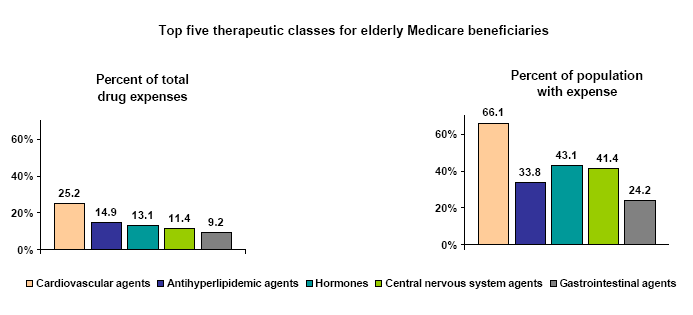
| Top five therapeutic classes for elderly Medicare beneficiaries |
Percent of total drug expenses
|
| Cardiovascular agents |
25.2% |
| Antihyperlipidemic agents |
14.9% |
| Hormones |
13.1% |
| Central Nervous system agents |
11.4% |
| Gastrointestinal agents |
9.2% |
|
| Top five therapeutic classes for elderly Medicare beneficiaries |
Percent of population
with expense
|
| Cardiovascular agents |
66.1% |
| Antihyperlipidemic agents |
33.8% |
| Hormones |
43.1% |
| Central Nervous system agents |
41.4% |
| Gastrointestinal agents |
24.2% |
|
Return to Table of Contents
What are the top five therapeutic classes of prescribed drugs when ranked by total expenses for non-elderly Medicare beneficiaries?
- In 2003, of the $15.6 billion spent on prescription drugs by the 5.7 million non-elderly (under age 65) Medicare beneficiaries, a larger percentage was spent on central nervous system agents (23%) than on psychotherapeutic agents (16%), cardiovascular agents (10%), and hormones (8%). These were three of the top four remaining in the top five therapeutic classes of drugs for which reliable estimates could be made.
- Of the top five therapeutic classes, central nervous system agents were
purchased by the highest percentage of persons (58%), followed by cardiovascular
agents (45%), psychotherapeutic agents (40%), anti-infectives (35%), and
hormones (32%).
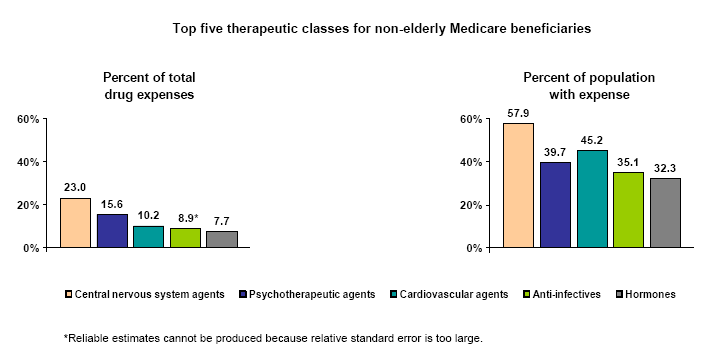
| Top five therapeutic classes for non-elderly Medicare beneficiaries |
Percent of total drug expenses
|
| Central nervous system agents |
23.0% |
| Psychotherapeutic agents |
15.6% |
| Cardiovascular agents |
10.2% |
| Anti-infectives |
8.9*% |
| Hormones |
7.7% |
| * Reliable estimates cannot be produced because relative standard error is too large. |
|
| Top five therapeutic classes for non-elderly Medicare beneficiaries |
Percent of population
with expense
|
| Central nervous system agents |
57.9% |
| Psychotherapeutic agents |
39.7% |
| Cardiovascular agents |
45.2 |
| Anti-infectives |
35.1% |
| Hormones |
32.3% |
|
Return to Table of Contents
What are the top five therapeutic classes of prescribed drugs when ranked by total expenses for the non-Medicare adult population?
- In 2003, of the $92.0 billion spent on prescription drugs by the 175.9 million persons in the non-Medicare adult population (age 18- 64),
a larger percentage was spent on hormones (16%) than on any other therapeutic
class. The remaining four therapeutic classes of drugs were psychotherapeutic
agents (13%), central nervous system agents (13%), cardiovascular agents
(13%), and gastrointestinal agents (10%).
- One-quarter of the adult non-Medicare population purchased at least one central nervous system agent. This was a higher percentage than for any of the other top five therapeutic classes of drugs.
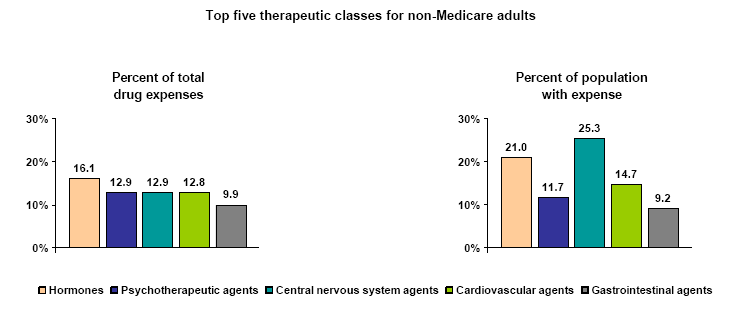
| Top five therapeutic classes for non-Medicare adults |
Percent of total drug expenses
|
| Hormones |
16.1% |
| Psychotherapeutic agents |
12.9% |
| Central Nervous system agents |
12.9% |
| Cardiovascular agents |
12.8% |
| Gastrointestinal agents |
9.9% |
|
| Top five therapeutic classes for non-Medicare adults |
Percent of population
with expense
|
| Hormones |
21.0% |
| Psychotherapeutic agents |
11.7% |
| Central Nervous system agents |
25.3% |
| Cardiovascular agents |
14.7% |
| Gastrointestinal agents |
9.2% |
|
Return to Table of Contents
What are the top five therapeutic classes of prescribed drugs when ranked by total expenses for children not on Medicare?
- In 2003, of the $10.4 billion spent on prescription drugs by the 72.3 million children under age 18 not on Medicare, a larger percentage was spent on respiratory agents (24%) than on psychotherapeutic agents (19%), anti-infectives (16%), central nervous system agents (12%), and topical agents (10%).
- A third (33%) of children not on Medicare used at least one anti-infective drug, which was a higher percentage than for any of the other therapeutic classes of drugs in the top five.
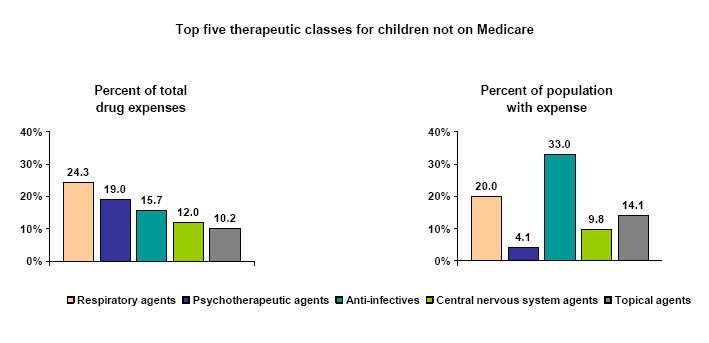
| Top five therapeutic classes for children not on Medicare |
Percent of total drug expenses
|
| Respiratory agents |
24.3% |
| Psychotherapeutic agents |
19.0% |
| Anti-infectives |
15.7% |
| Central nervous system agents |
12.0% |
| Topical agents |
10.2% |
|
| Top five therapeutic classes for children not on Medicare |
Percent of population
with expense
|
| Respiratory agents |
20.0% |
| Psychotherapeutic agents |
4.1% |
| Anti-infectives |
33.0% |
| Central nervous system agents |
9.8% |
| Topical agents |
14.1% |
|
Return to Table of Contents
References
Berk ML, Monheit, AC. The concentration of health care expenditures, revisited. Health Aff March/April 2001; 20(2):9- 18.
Cohen J. Design and methods of the Medical Expenditure Panel Survey Household Component. Rockville (MD): Agency for Health Care Policy and Research; 1997. MEPS Methodology Report No. 1. AHCPR Pub. No. 97-0026.
Cohen S. Sample design of the 1996 Medical Expenditure Panel Survey Household Component. Rockville (MD): Agency for Health Care Policy and Research; 1997. MEPS Methodology Report No. 2. AHCPR Pub. No. 97-0027.
Cohen S. Design strategies and innovations in the Medical Expenditure Panel Survey. Medical Care, July 2003: 41(7) Supplement: III-5- III-12.
Moeller JF, Stagnitti MN, Horan E, et al. Outpatient prescription drugs: Data collection and editing in the 1996 Medical Expenditure Survey (HC-010A). Rockville (MD): Agency for Healthcare Research and Quality; 2001. MEPS Methodology Report No. 12. AHRQ Pub. No. 01-0002.
Stagnitti MN, Miller GE, Moeller JF. Outpatient prescription drug expenses, 1999. Rockville (MD): Agency for Healthcare Research and Quality; 2003. MEPS Chartbook No.12. AHRQ Pub. No. 04-0001.
2003 Medical Expenditure Panel Survey-Table Compendium. March 2003. Agency for Healthcare Research and Quality, Rockville, MD.
2003 Medical Expenditure Panel Survey Full Year Consolidated Data File: MEPS HC-079. Rockville (MD): Agency for Healthcare Research and Quality; 2005.
2003 Medical Expenditure Panel Survey Prescribed Medicines File: MEPS HC-077A.
Rockville (MD): Agency for Healthcare Research and Quality; 2005.
Please consult the MEPS Web site (www.meps.ahrq.gov) for an updated publications list and other information from MEPS. For additional information, contact the MEPS project director at mepspd@ahrq.gov.
Definition of Terms
Outpatient Prescription Medicines
This category covers expenses for all outpatient prescription medications that the household or individual purchased or refilled from a pharmacy provider not in an inpatient setting. It includes expenses for insulin and diabetic supplies and equipment. It does not include over-the-counter medicines.
Source of Payment The percentages of sources of payment shown here represent the share of total expenses (summed across all persons) paid for by each payment source. Sources of payment are classified as follows:
Out-of-pocket-This category includes payments by user
or family.
Private insurance-Private insurance includes payments
made by major medical insurance plans covering hospital and medical
care (excluding payments from Medicare, Medicaid, and other public
sources). Payments from Medigap plans for Medicare beneficiaries,
TRICARE, and other private are included. Payments from plans that
provide coverage for a single service only, such as dental or vision
coverage, are not included.
Public insurance-Public insurance includes Medicare;
Medicaid; Department of Veterans Affairs (excluding TRICARE); other
Federal sources (Indian Health Service, military treatment facilities,
and other care provided by the Federal Government); various State
and local sources (community and neighborhood clinics, State and
local health departments, and State programs other than Medicaid);
Medicaid payments reported for persons who were not enrolled in
the Medicaid program at any time during the year; and other public
sources of payment.
Other-This category includes Workers-Compensation;
unclassified sources (automobile, homeowner's, or liability
insurance and other miscellaneous or unknown sources); and any
type of private insurance payments reported for people without
private health insurance coverage during the year.
Population Characteristics
In general, population characteristics were measured as of December 31, 2003, or the last date that the sample person was part of the civilian noninstitutionalized population living in the United States prior to December 31, 2003. Subgroups within this population are defined as follows:
Medicare beneficiary/non-Medicare population-People are
considered Medicare beneficiaries if they ever report being covered
by Medicare while in the survey. For analytic purposes, this classification
also includes a very small number of persons age 65 and older who
did not report Medicare coverage. All others are considered members
of the non-Medicare population.
Elderly/non-elderly-People are considered elderly if their last available age (for most persons, this is their age at the end of the year) was age 65 or older. All others are considered non-elderly.
Adult/child-People are considered adults if their last available age (for most persons, this is their age at the end of the year) was age 18 or older. Those under age 18 are considered children.
Health Insurance Status
Individuals under age 65 were classified into the following three insurance categories:
Any private health insurance-Individuals with insurance that provides coverage for hospital and physician care at any time during the year, other than Medicare, Medicaid, or other public hospital/physician coverage are classified as having private insurance. Medigap coverage is included in this category. Persons with TRICARE are also included. Insurance that provides coverage for a single service only, such as dental or vision, is not included.
Public coverage only-Individuals are considered to have public coverage only if they met both of the following criteria:
- They were not covered by private insurance at any time during the year.
- They were covered by one of the following public programs at any point during the year: Medicare, Medicaid, or other public hospital/physician coverage.
Uninsured-The uninsured are defined as persons not covered by Medicare, TRICARE, Medicaid, other public hospital/physician programs, or private hospital/physician insurance at any time during 2003. Individuals covered only by noncomprehensive State-specific programs (e.g., Maryland Kidney Disease Program, Colorado Child Health Plan) or private single-service plans (e.g., coverage for dental or vision care only, coverage for accidents or specific diseases) are not considered to be insured.
Individuals age 65 and older were classified into the following three insurance categories:
Medicare and private insurance-This category includes persons classified as Medicare beneficiaries and covered by Medicare and a supplementary private policy.
Medicare and other public insurance-This category includes persons classified as Medicare beneficiaries who met both of the following criteria:
- They were not covered by private insurance at any point during the year.
- They were covered by one of the following public programs at any point during the year: Medicaid, other public hospital/physician coverage.
Medicare only-This category includes persons classified as Medicare beneficiaries but not classified as Medicare and private insurance or as Medicare and other public insurance. This group includes persons who were enrolled in Medicare HMOs and persons who had Medicare fee-for-service coverage only.
Income
Each person was classified according to the total 2003 income
of his or her family. Within a household, all individuals related
by blood, marriage, or adoption were considered to be a family.
Personal income from all family members was summed to create family
income. Possible sources of income included annual earnings from
wages, salaries, bonuses, tips, and commissions; business and farm
gains and losses; unemployment and Worker's Compensation;
interest and dividends; alimony, child support, and other private
cash transfers; private pensions, IRA withdrawals, Social Security,
and veterans' payments; Supplemental Security Income and
cash welfare payments from public assistance, Aid to Families with
Dependent Children, and Aid to Dependent Children; gains or losses
from estates, trusts, partnerships, S corporations, rent, and royalties;
and a small amount of other income.
Poverty status is the ratio of family income to the 2003 Federal poverty thresholds, which vary by family size and age of the head of the family. Those categories are:
Poor-Persons in families with income less than or equal to 100% of the poverty line are considered poor. Some of these persons are in families reporting negative income.
Near poor-Persons in families with income over 100% through 125% of the poverty line are considered near poor.
Low income-Persons in families with income over 125% through 200% of the poverty line are considered low income.
Middle income-Persons in families with income over 200% through 400% of the poverty line are considered middle income.
High income-Persons in families with income over 400% of the poverty line are considered high income.
Perceived Health Status
The MEPS respondent was asked to rate the health of each person in the family according to the following categories: excellent, very good, good, fair, and poor. Health status was missing for approximately 1.1% of the total population.
Therapeutic Classifications
Each drug that was listed as purchased or otherwise obtained in the MEPS Prescribed Medicines (PMED) File HC-077A was assigned to a major therapeutic class by linking the PMED file to the Multum Lexicon database, a product of Cerner Multum, Inc. Therapeutic classes were assigned to drugs using Multum Lexicon variables from Cerner Multum, Inc. The therapeutic class of central nervous system agents includes the large subclass of analgesics. The therapeutic class of antihyperlipidemic agents includes the large subclass of HMG-COA reductase inhibitors. The therapeutic class of psychotherapeutic agents includes the large subclass of antidepressants. For additional information on these and other Multum Lexicon variables, as well as the Multum Lexicon database itself, please refer to the following Web site: http://www.multum.com/Lexicon.htm.
The Multum therapeutic classification system is designed to replicate the type of organizational schemes used in practice by physicians and pharmacists. It is important to note that the assigned therapeutic class for a particular drug purchase in MEPS will not always correspond to the reported condition for the drug. Also, a small percentage of drug purchases were assigned to more than one major therapeutic class. These drugs were assigned to a single therapeutic class using a combination of condition information and random assignment. Finally, a small percentage of drugs did not link to the Multum Lexicon database and were excluded from Section 3 analyses.
Return to Table of Contents
Suggested Citation:
Stagnitti, MN. Chartbook #16: Outpatient Prescription
Drug Expenses in the U.S. Community Population, 2003. March 2006. Agency for
Healthcare Research and Quality, Rockville, MD. http://www.meps.ahrq.gov/data_files/publications/cb16/cb16.shtml |
|
